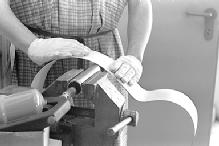


The neck is made of a single maple or mahogany blank.
The headplate is sawn off this neckblank and glued to it again to
achive an angled peghead.


The heelblock is glued to the other end. The neck-body connection
is sawn.


Fretslots are sawn into a seperate fingerboard, which is glued on
the neck afterwards.


The frets are hammered in and the tunerholes are drilled.

Finally the neck is shaped and fine sanded.


Two plates, sawn off the same blank, are glued together to achieve
a bookmatched top. It is planed to a final thickness of approx. 2.8
to 3 mm. The back and sides are planed very thin too, the sides are
wet and bent over a hot pipe.


String tension can apply high forces to a guitar. To add strengh,
braces are glued to the top and the back. The braces are shaped as
light as necessary. Tapping the braced top gives the experienced
luthier an idea of how far he can go.


A lining is glued to the sides to give more area for gluing on the
top and the back. The back is arched and therefore glued on with
the help of a rubberband made of a car (or truck) inner tube.


The back- and top plates are trimmed flush to the sides. Around the
body edges a purfling is inlayed. An important step is fretwork and
setup. It makes the guitar playable without fret buzzes.

The last step is stringing the guitar, tuning and enjoy playing the
new instrument. The sound will improve over the next weeks and
months.